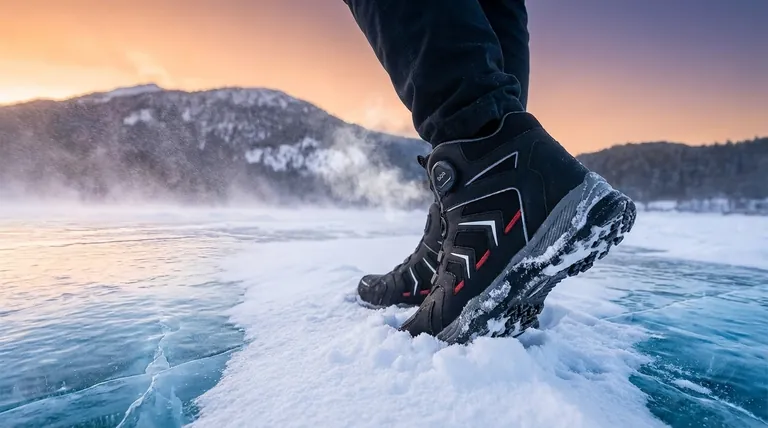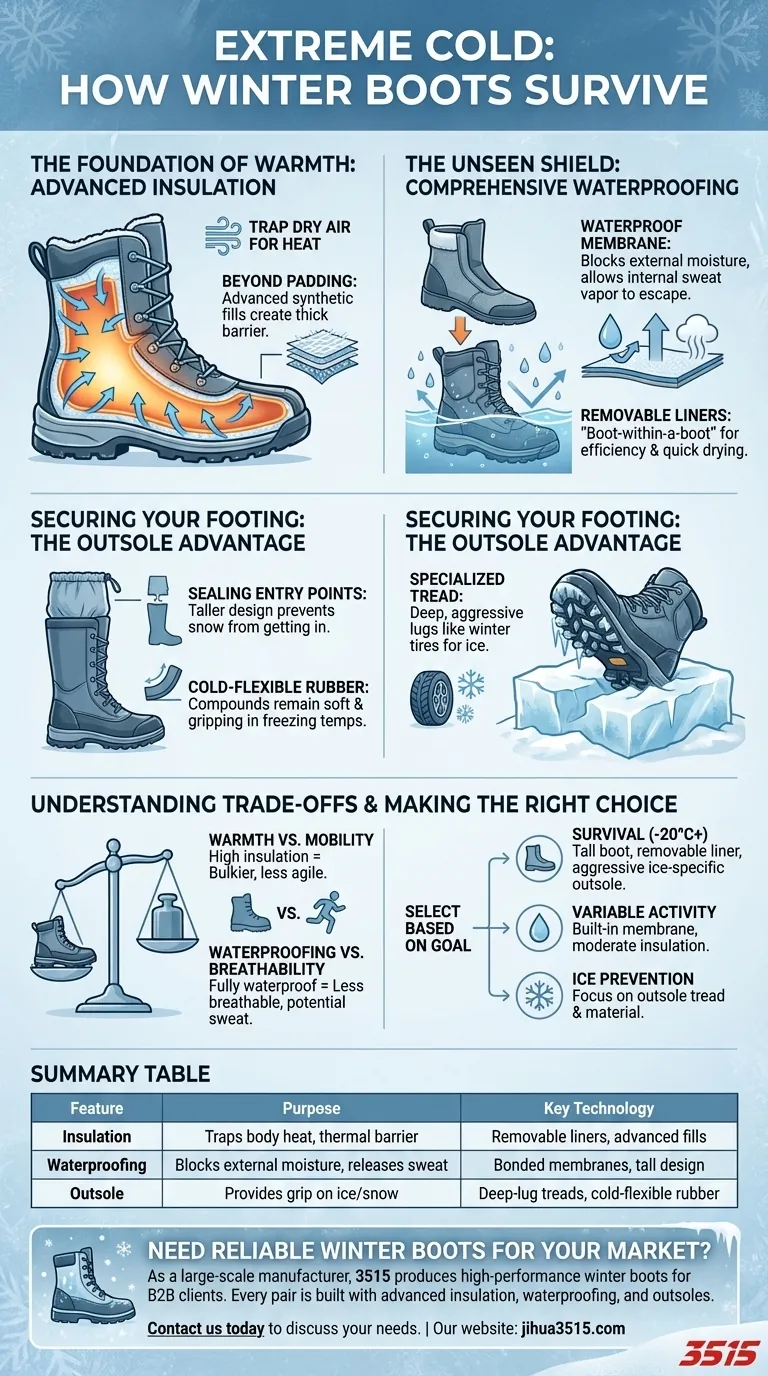In essence, winter boots designed for extreme cold function as a multi-part system combining advanced insulation, comprehensive waterproofing, and specialized outsoles. These elements work together to retain body heat, block external moisture while releasing internal sweat, and ensure stable footing on hazardous surfaces like ice and snow.
The critical difference in boots for extreme cold isn't a single feature, but a purpose-built system. Success depends on trapping dry air for warmth, completely blocking external moisture, and maintaining grip when materials become brittle.

The Foundation of Warmth: Advanced Insulation
A boot's primary defense against the cold is its ability to trap air, and in extreme conditions, standard insulation is not enough.
Beyond Standard Padding
Boots for severe cold utilize additional insulation layers or advanced synthetic fills. The goal is to create a thick barrier of trapped air that slows the transfer of heat from your foot to the frigid environment.
The Power of Removable Liners
The most effective systems often feature separate inner liners, similar to those found in high-performance snowboard or mountaineering boots. This creates a "boot-within-a-boot" that drastically increases thermal efficiency and allows the liner to be removed for quick drying.
The Unseen Shield: Comprehensive Waterproofing
Staying warm is impossible if your feet are wet. Moisture rapidly pulls heat away from the body, making waterproofing a non-negotiable feature.
Why Dryness Equals Warmth
Elite cold-weather boots use waterproof membranes that are bonded to the boot's materials. This technology is crucial because it performs two jobs at once.
First, it creates an impenetrable barrier against external water from snow, slush, or rain. Second, it is breathable, allowing sweat vapor (moist air) to escape, keeping your feet dry from the inside out.
Sealing the Entry Points
The most waterproof boot is useless if snow can get in over the top. For this reason, boots designed for deep cold are typically taller, often extending below the knee. They are often paired with waterproof pants or gaiters to create a complete seal.
Securing Your Footing: The Outsole Advantage
Extreme cold often means walking on ice, compacted snow, and unpredictable terrain. The boot's outsole is your point of contact and is engineered for safety.
Specialized Tread for Ice
The outsoles of these boots feature deep, aggressive lugs with tread designs comparable to automotive winter tires. This design bites into snow and provides channels to move slush away from the contact point, maximizing grip.
Material Composition Matters
The rubber compounds used are also specialized. They are engineered to remain soft and flexible in deep-freezing temperatures, preventing them from becoming hard and slick like standard rubber would.
Understanding the Trade-offs
No single boot is perfect for every winter scenario. Understanding the compromises is key to choosing the right tool for the job.
Warmth vs. Mobility
Extremely insulated boots are often bulkier and heavier. While they provide maximum thermal protection when stationary or moving slowly, they can be cumbersome for high-exertion activities.
Waterproofing vs. Breathability
While modern membranes are excellent, a fully waterproof, high-cut boot will always be less breathable than a lower-cut, water-resistant shoe. In milder conditions, this can lead to excessive sweating.
The "One Boot Fits All" Myth
A boot designed for -30°C will be overkill for a day that is just below freezing. As the references suggest, having multiple footwear options for varying winter conditions is the most effective strategy.
Making the Right Choice for Your Goal
Select your boot based on the most extreme conditions you realistically expect to face.
- If your primary focus is survival in deep cold (-20°C and below): Prioritize a tall boot with a separate, removable insulation liner and an aggressive, ice-specific outsole.
- If your primary focus is activity in variable winter conditions: A boot with a built-in waterproof membrane and a moderate amount of insulation offers the best versatility.
- If your primary focus is preventing slips on ice: Pay closest attention to the outsole's tread design and material, as this is your most critical safety feature.
Ultimately, choosing the right boot is about understanding that in extreme cold, your footwear is a critical piece of survival equipment.
Summary Table:
| Feature | Purpose | Key Technology |
|---|---|---|
| Insulation | Traps body heat, creates thermal barrier | Removable liners, advanced synthetic fills |
| Waterproofing | Blocks external moisture, releases sweat vapor | Bonded waterproof membranes, tall boot design |
| Outsole | Provides grip on ice and snow | Deep-lug treads, cold-flexible rubber compounds |
Need Reliable Winter Boots for Your Market?
As a large-scale manufacturer, 3515 produces a comprehensive range of high-performance winter boots for distributors, brand owners, and bulk clients. Our production capabilities ensure every pair is built with the advanced insulation, waterproofing, and outsoles detailed above, providing your customers with the safety and warmth they need in extreme conditions.
Contact us today to discuss your winter footwear needs and leverage our manufacturing expertise.
Visual Guide

Related Products
- Wholesale Safety Footwear Manufacturer for Bulk & Custom OEM Orders
- Premium Wholesale Waterproof Safety Boots High Performance Protection for Industrial Markets
- Customizable Anti-Smash Safety Boots for Wholesale & Private Label Manufacturing
- Custom Wholesale Leather Safety Boots Direct Factory Manufacturing
- Premium Grain Leather Safety Boots for Bulk Supply
People Also Ask
- What's the difference between safety toe and steel toe? Choose the Right Protective Footwear.
- Do moc toe boots have steel toe? Get Durable, Safety-Compliant Footwear
- How do safety shoes contribute to cost savings for companies? A Strategic Investment in Risk and Cost Management
- Why is manufacturer diversity and inclusion important in work boot design? For Superior Fit, Safety & Comfort
- Is safety toe better than steel toe? A Guide to Choosing the Right Protection



















